weight AUDI S7 2013 User Guide
[x] Cancel search | Manufacturer: AUDI, Model Year: 2013, Model line: S7, Model: AUDI S7 2013Pages: 310, PDF Size: 77.45 MB
Page 158 of 310
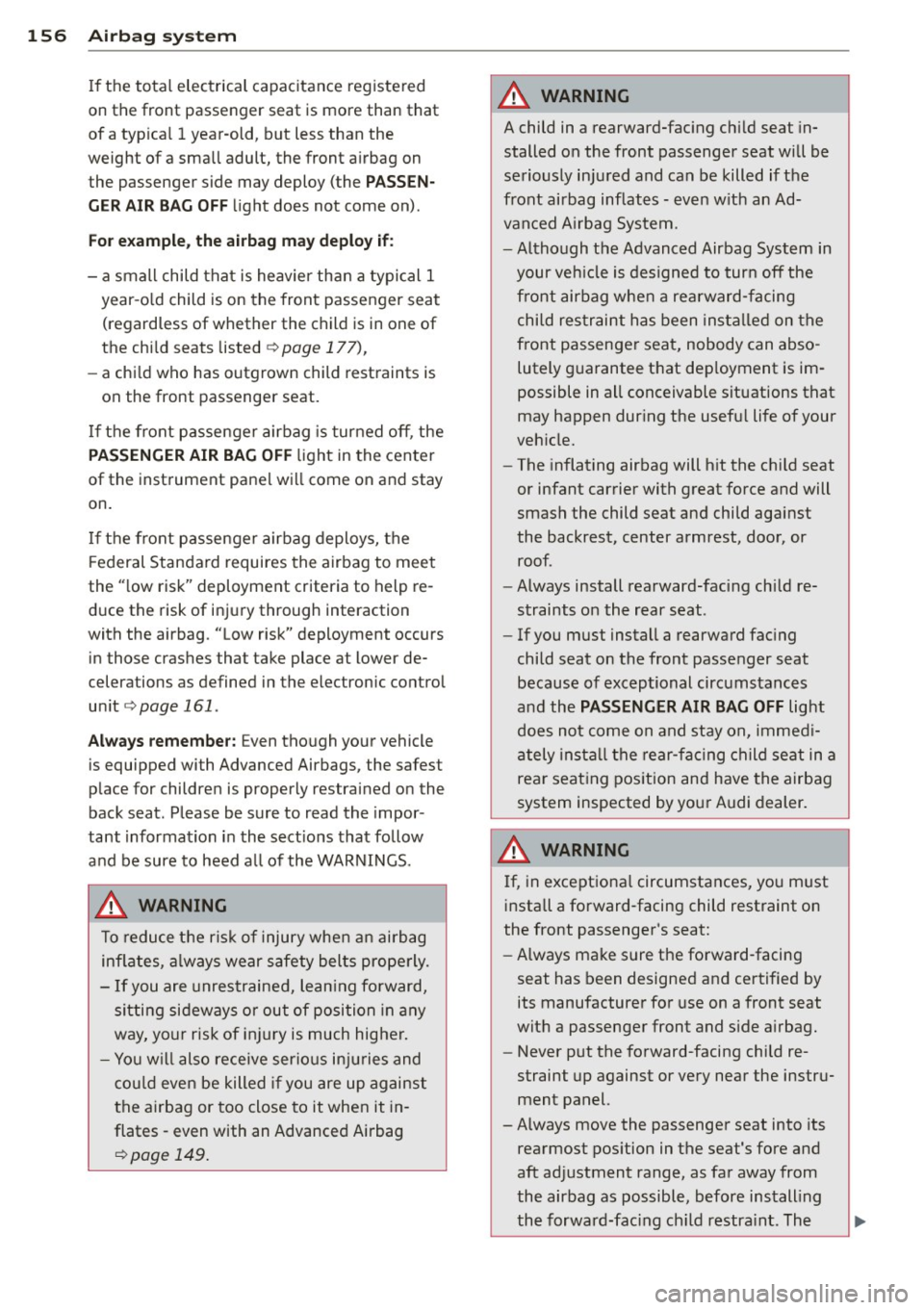
156 Airbag sys te m
If the tota l electrical capacitance registe red
on the front passenger seat is more than that
of a typ ica l 1 year-old, but less than the
weight of a small adult, the front a irbag on
the passenger side may deploy (the
PA SSE N
GER AIR BAG OFF
li ght does not come on).
For e xample , the airbag m ay deploy if :
-a small child that is heavier than a typical 1
year-o ld child is on the front passenger seat
(regardless of whether the child is in one of
the chi ld seats listed
¢ page 177),
-a chi ld who has outgrown child restraints is
on the front passenger seat.
If the front passenger airbag is turned off, the
PASSENGER AIR BAG OFF light in the center
of the instrument panel wi ll come on and stay
on.
If the front passenger airbag deploys, the
F ederal Standard requires the airbag to meet
the " low risk" deployment criteria to help re
d uce the risk of injury through interaction
with the airbag. "Low risk" deployment occurs
in those crashes that take place at lower de
celerations as defined in the electronic control un it
¢ page 161.
Alw ays rem ember : Even though your vehicle
is equipped with Advanced Airbags, the safest
place for children is properly restrained on the
back seat . Please be sure to read the impor
tant information in the sect ions that follow
and be sure to heed a ll of the WARNINGS.
.&_ WARNING
To reduce the risk of injury when an airbag
inflates, a lways wear safety belts prope rly.
- If you are unrestrained, lean ing fo rward,
sitting sideways or out of position in any
way, your risk of injury is much higher.
- You w ill also receive serio us injuries and
cou ld even be killed if you are up against
the a irbag or too close to it when it in
flates - even with an Advanced Airbag
¢page 149.
.&_ WARNING
A child in a rearward-fac ing ch ild seat in
stalled on the front passenger seat will be
seriously injured and can be killed if the
front airbag inflates - even w ith an Ad
van ced A irbag System.
- Altho ugh the Advanced Airbag System in
your veh icle is designed to turn off the
front airbag when a rearward-facing
child restraint has been instal led on the
front passenger seat, nobody can abso
lutely g uarantee that dep loyment is im
possible in all conceivable situations that
may happen dur ing the usefu l life of your
veh icle.
- The inflating airbag will h it the ch ild seat
or infant carrier with great force and will
smash the child seat and child against
the backrest, center armrest, door, or roof.
- Always install rearward-facing ch ild re
straints on the rear seat .
- If you must install a rearward fac ing
child seat on the front passenger seat because of exceptional circumstances
and the
PASSENGER AIR BAG OFF light
does not come on and stay on, immed i
a tely insta ll the rear-facing child seat in a
rear seat ing pos ition and have the airbag
system inspected by your Audi dealer.
.&_ WARNING ,..___
If, in except iona l circumstances, you m ust
install a forward -facing child restraint on
the front passenger's seat:
- Always make sure the forward-facing
seat has been designed and certified by
its manufacturer for use on a front seat
with a passenger front and s ide a irbag.
- Never p ut the forward-facing child re
straint up against or very near the instru
ment panel.
- Always move the passenger seat into its
rearmost pos ition in the seat's fore and
aft ad justment range, as far away from
the airbag as possible, before install ing
the forward-fac ing ch ild restra int. The
-
Page 166 of 310
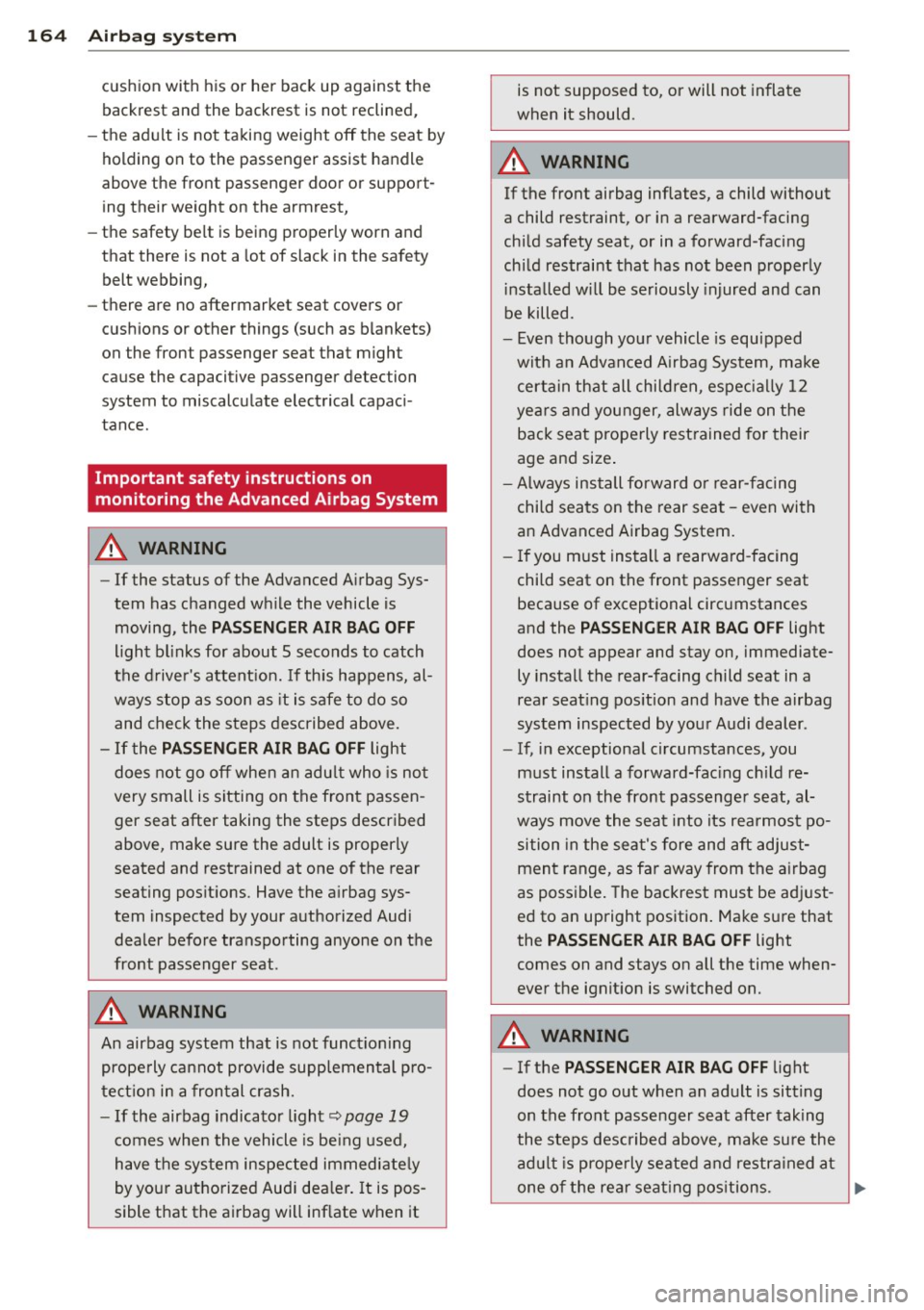
164 Airbag sys te m
cushion wit h his or her back up against the
backrest and the backrest is n ot reclined,
- the adu lt is not taking weight off the seat by
holding on to the passenger assist handle
above the front passenger door or support
ing their weight on the armrest,
- the safety be lt is being properly worn and
that there is not a lot of slack in the safety
belt webbing,
- there are no aftermarket seat covers or
cushions or other things (such as b lankets)
on the front passenger seat that might
cause the capacitive passenger detection
system to miscalculate electrical capac i
tance .
Important safety instructions on
monitoring the Advanced Airbag System
A WARNING
-If the status of the Advanced A irbag Sys
tem has changed wh ile the vehicle is
moving, the
PASSENGER AIR BAG OFF
light blinks for about 5 seconds to catch
the drive r's attent ion.
If this happens, al
ways s top as soon as it is safe to do so
and check the steps described above.
- If the
PASSENGER AIR BAG OFF light
does not go off when an adu lt who is no t
very small is sitting on the front passen
ger seat after taking the steps described
above, make sure the adult is properly
seated and restrained at one of the rear
seating pos itions. Have the a irbag sys
tem inspected by your authorized Audi
dealer before transpo rting anyone on the
front passenger seat.
A WARNING , --
An airbag system that is not funct io ning
prope rly cannot provide supplemental p ro
tect ion in a fron tal crash.
- If the airbag indicator light ~ page 19
comes when the vehicle is be ing used,
have t he system inspected immedi ate ly
by yo ur authorized Aud i dea ler .
It is pos
sible that the airbag will inflate when it is not supposed to, or will not
inflate
when it should.
A WARNING
-If the front airbag inflates, a child without
a child restraint, or in a rearward-facing
chi ld safety seat, or in a forward -facing
chi ld restraint that has not been proper ly
i nstalled w ill be seriously injured and can
b e killed.
- Even though you r vehicle is equipped
with an Adva nced A irbag System, make
certain that all children, espe cial ly 12
ye ars and you nger, always ride on the
back seat properly rest rained for their
age and size .
- Always inst all forward o r rear-fa cing
child seats on the rear sea t - even with
an Advanced Airbag System.
- If you must ins tall a rearwa rd -facing
child seat on the front passenger seat because of exceptional circumstances
and the
PASSENGER AIR BAG OFF light
does not appear and stay on, immediate
ly install the rear-facing child seat in a
rea r seat ing pos ition and have the airbag
sys tem inspected by you r Audi dealer .
- If, in exceptiona l circumstances, you
m ust install a forward-fac ing c hild re
straint on the front passenger seat, al
ways move the seat into its rearmos t po
sition in the se at's fore and aft adjust
men t range, as far away from the a irbag
as poss ible . The backrest mus t be ad just
ed to an upright pos ition . Make su re that
the
PASSENGER AIR BAG OFF light
comes on and stays on all the time when
ever the ignit ion is switched on.
A WARNING
-
- If the PASSENGER AIR BAG OFF light
does not go out when an adult is sitting
on the front passe nger seat after taking
the steps described above, make su re the
adu lt is prope rly seated a nd restra ined at
one o f the rea r seat ing pos itions.
~
Page 173 of 310
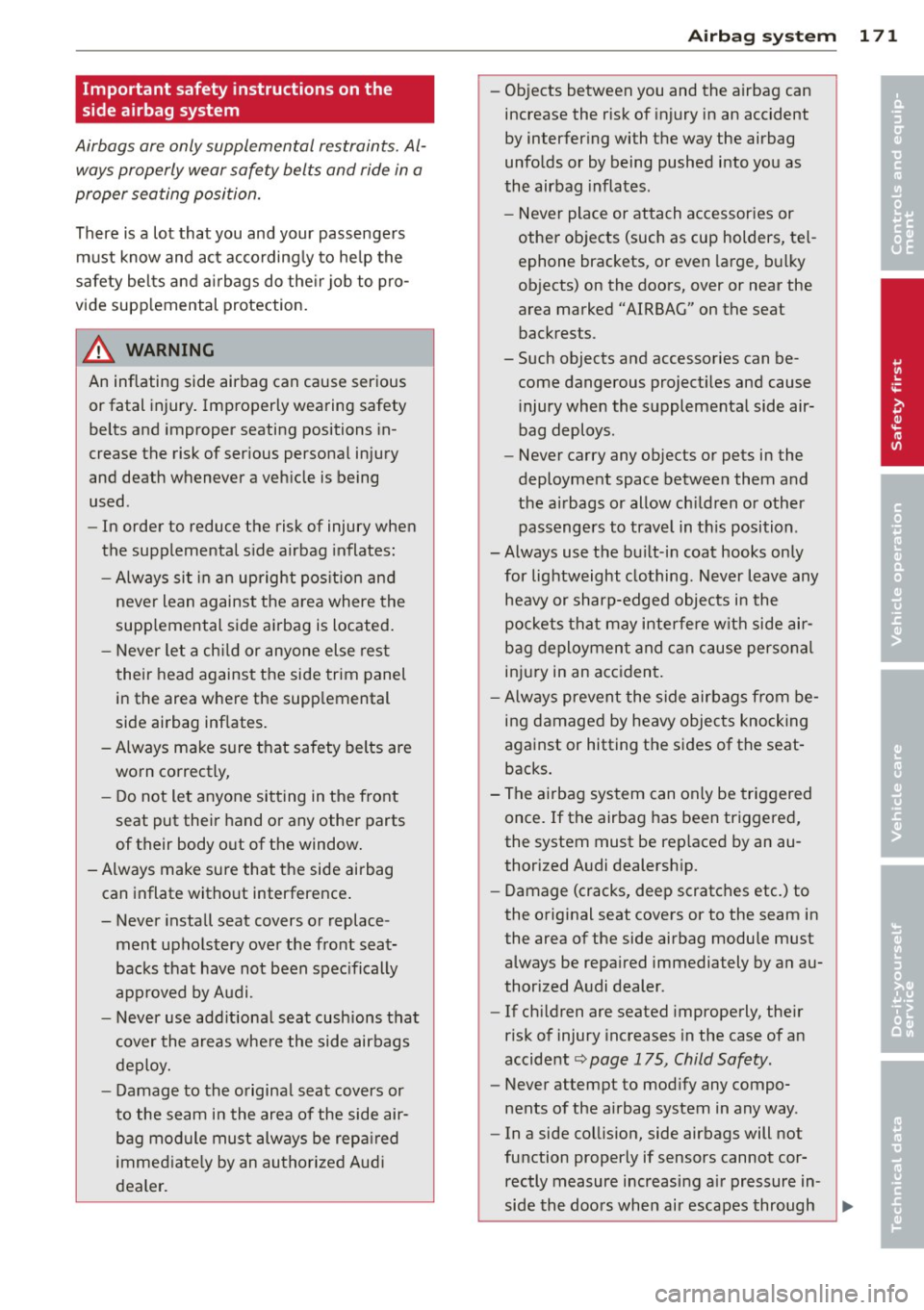
Important safety instructions on the
side airbag system
Airbags are only supplemental restraints. Al
ways properly wear safety belts and ride in a
proper seating position.
There is a lot that you and your passengers
must know and act accordingly to help the
safety belts and airbags do their job to pro
vide supplemental protection .
A WARNING
An inflating side airbag can cause serious
or fatal injury. Improperly wearing safety
belts and improper seating positions in
crease the risk of serious personal injury
and death whenever a vehicle is being
used .
- In order to reduce the risk of injury when
the supplemental side airbag inflates:
-Always sit in an upright position and
never lean against the area where the
supplemental side airbag is located.
- Never let a child or anyone else rest
their head against the side trim panel
in the area where the supplemental
side airbag inflates.
- Always make sure that safety belts are worn correctly,
- Do not let anyone sitting in the front
seat put their hand or any other parts
of their body out of the window.
- Always make sure that the side airbag can inflate without interference.
- Never install seat covers or replace
ment upholstery over the front seat
backs that have not been specifically
approved by Audi.
- Never use additional seat cushions that
cover the areas where the side airbags
deploy.
- Damage to the original seat covers or
to the seam in the area of the side air bag module must always be repaired
immediately by an authorized Audi
dealer.
Airbag system 171
- Objects between you and the airbag can
increase the risk of injury in an accident
by interfering with the way the airbag
unfolds or by being pushed into you as
the airbag inflates.
- Never place or attach accessories or
other objects (such as cup holders, tel
ephone brackets, or even large, bulky
objects) on the doors, over or near the
area marked "AIRBAG" on the seat backrests .
- Such objects and accessories can be come dangerous projectiles and cause
injury when the supplemental side air
bag deploys.
- Never carry any objects or pets in the
deployment space between them and
the airbags or allow children or other passengers to travel in this position .
- Always use the built -in coat hooks only
for lightweight clothing . Never leave any
heavy or sharp-edged objects in the
pockets that may interfere with side air
bag deployment and can cause personal
injury in an accident.
- Always prevent the side airbags from be
ing damaged by heavy objects knocking
against or hitting the sides of the seat
backs.
- The airbag system can only be triggered
once. If the airbag has been triggered,
the system must be replaced by an au
thorized Audi dealership.
- Damage (cracks, deep scratches etc .) to
the original seat covers or to the seam in
the area of the side airbag module must always be repaired immediately by an au
thorized Audi dealer .
- If children are seated improperly, their
risk of injury increases in the case of an
accident ~
page 175, Child Safety.
-Never attempt to modify any compo
nents of the airbag system in any way .
- In a side collision, side airbags will not
function properly if sensors cannot cor rectly measure increasing air pressure in-
side the doors when air escapes through .,.. •
•
Page 176 of 310
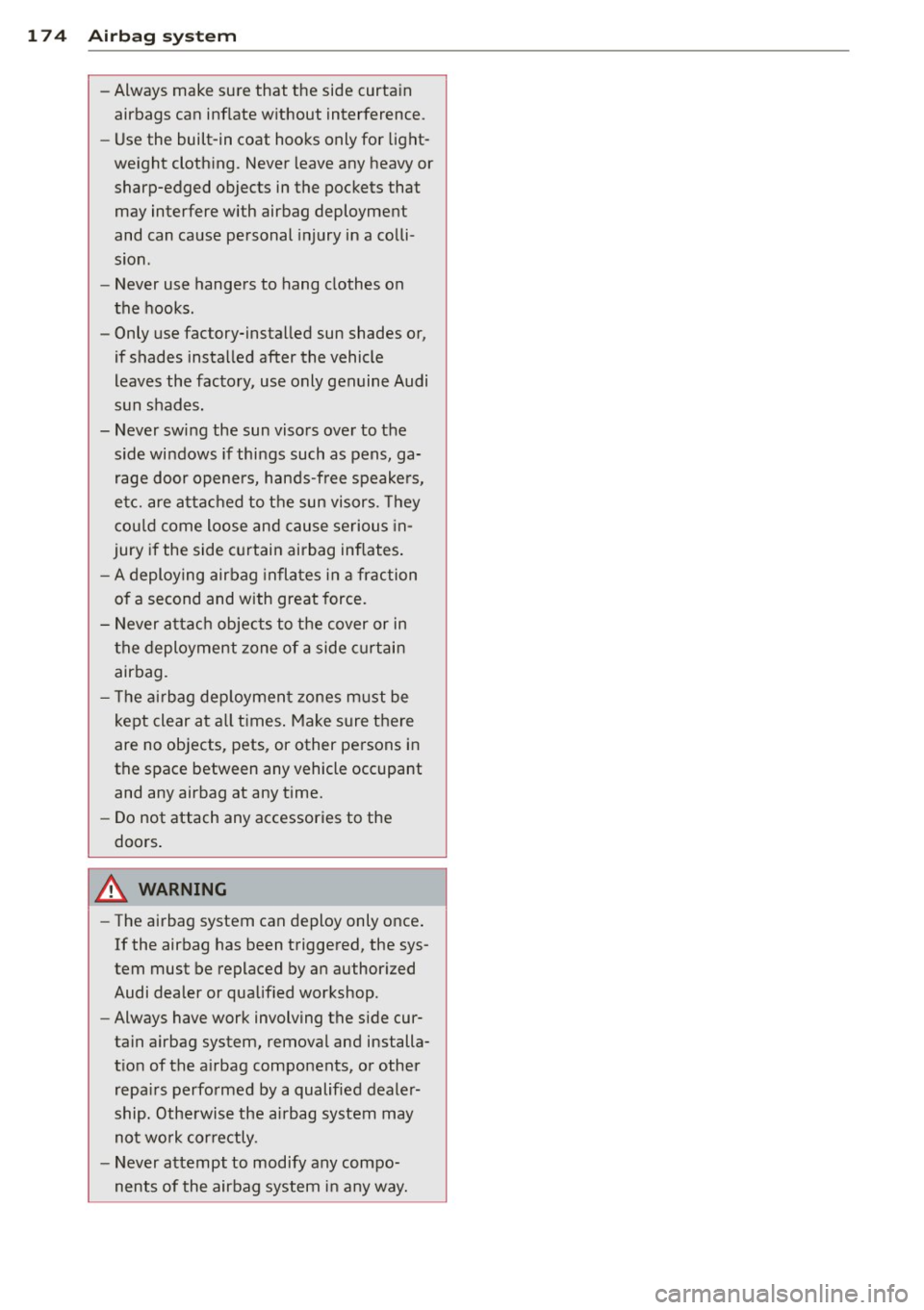
174 Airbag system
-Always make sure that the side curtain
airbags can inflate without interference.
- Use the built-in coat hooks only for light
weight clothing. Never leave any heavy or
sharp-edged objects in the pockets that may interfere with airbag deployment
and can cause personal injury in a colli
sion.
- Never use hangers to hang clothes on
the hooks.
- Only use factory-installed sun shades or,
if shades installed after the vehicle
leaves the factory, use only genuine Audi
sun shades.
- Never swing the sun visors over to the side windows if things such as pens, ga
rage door openers, hands-free speakers,
etc. are attached to the sun visors. They
could come loose and cause serious in
jury if the side curtain airbag inflates.
- A deploying airbag inflates in a fraction
of a second and with great force.
- Never attach objects to the cover or in
the deployment zone of a side curtain
airbag.
- The airbag deployment zones must be
kept clear at all times. Make sure there
are no objects, pets, or other persons in
the space between any vehicle occupant and any airbag at any time.
- Do not attach any accessories to the
doors.
A WARNING
-The airbag system can deploy only once.
If the airbag has been triggered, the sys
tem must be replaced by an authorized
Audi dealer or qualified workshop.
- Always have work involving the side cur
tain airbag system, removal and installa
tion of the airbag components, or other
repairs performed by a qualified dealer
ship. Otherwise the airbag system may
not work correctly.
- Never attempt to modify any compo
nents of the airbag system in any way.
Page 177 of 310
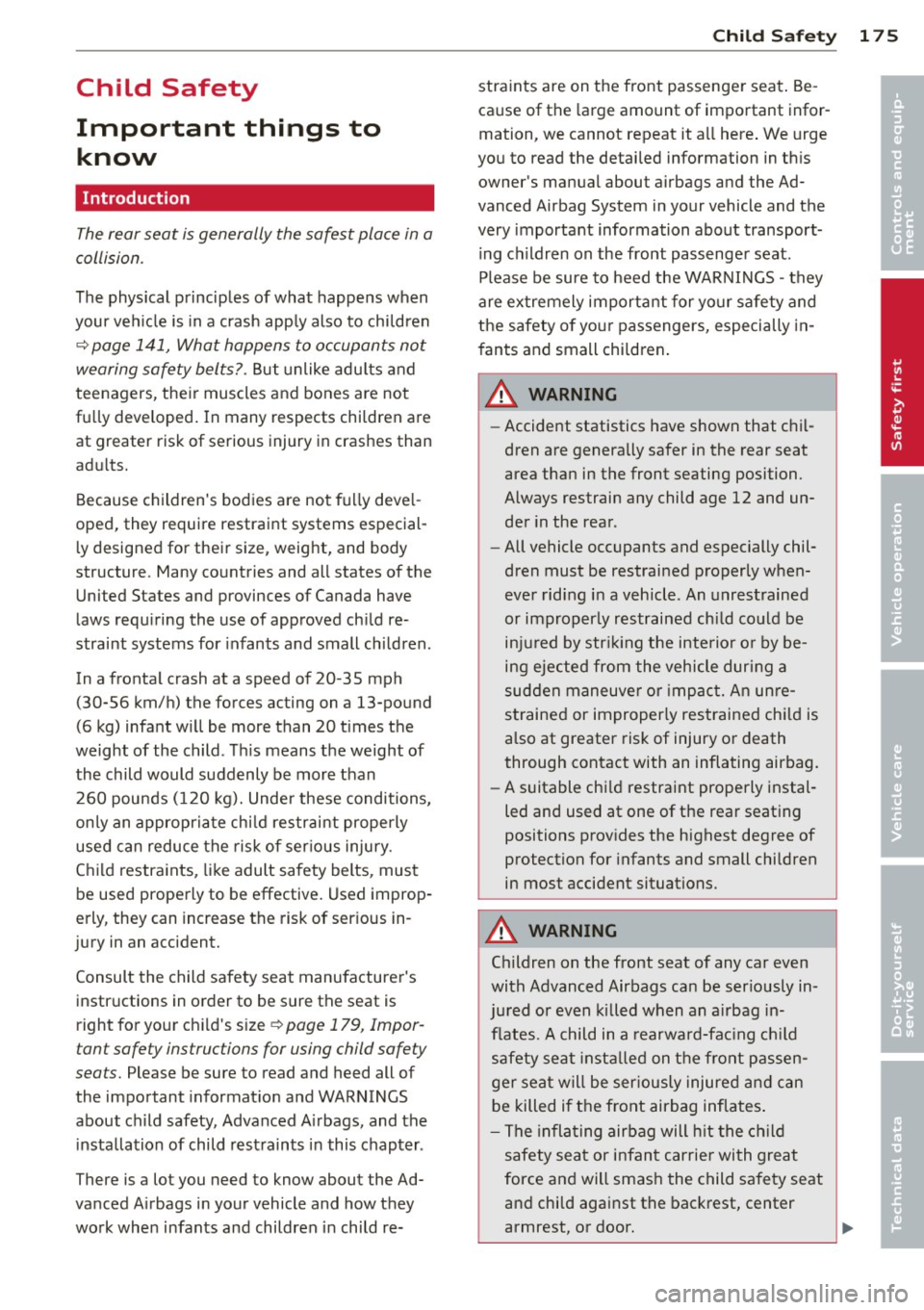
Child Safety
Important things to know
Introduction
The rear seat is generally the safest place in a
collision.
The physical principles of what happens when
your veh icle is in a crash app ly also to chi ldren
~ page 141, What happens to occupants not
wearing safety belts?.
But unlike adu lts and
teenagers, their muscles and bones are not
fu lly developed . In many respects children are
at greater risk of serious injury in crashes than
ad ults.
Because children's bod ies a re not fu lly deve l
oped, they require restraint systems especial l y designed for their size, weight, and body
structure. Many co untries and all states of the
United States and provinces of Canada have
laws requ iring the use of approved ch ild re
straint systems for infants and small children.
In a fronta l crash at a speed of 20 -35 mph
(30-56 km/h) the forces acting on a 13-pound
(6 kg) infa nt w ill be more than 20 t imes the
weight of the child . T his means the weight of
the child would suddenly be more than
260 pounds ( 120 kg). Under these conditions,
on ly an appropr ia t e chi ld restraint properly
used can reduce the risk of ser ious injury.
Ch ild restra ints, like adult safety belts, must
be used properly to be effective. Used improp
erly, they can increase the risk of ser ious in
jury in an accident.
Consult the ch ild safety seat manufacture r's
instr uctions in order to be sure the seat is
right fo r you r ch ild's size ~
page 179, Impor
tant safety instructions for using child safety
seats.
Please be sure to read and heed all of
the impo rtant informat ion and WARNINGS
about ch ild safety, Advanced A irbags, and the
i nstallation of child rest raints in this chapter .
There is a lot you need to know about the Ad
vanced A irbags in your vehicle and how they
wo rk when infants and children in child re-
Child Sa fet y 175
stra ints are on the front passenge r seat . Be
ca use of the large amount of important infor
mation, we cannot repeat it a ll here . We urge
you to read the detailed information in th is
owner's manua l about airbags and the Ad
vanced Airbag System in your vehicle and the
very important information about transport
ing children on the front passenge r seat .
Please be sure to heed the WARN INGS -they
are ex tremely importa nt for yo ur safety and
the safety o f you r passengers, especially in
f ants and small chi ldren .
.A, WARNING
-Accident statistics have shown that c hil
dren a re generally safer in the rear seat
area than in the front seating position.
Always restrain any child age 12 and un der in the rea r.
- All vehicle occupants and especially chil
dren must be restrai ned p roperly when
eve r riding in a vehicle . An unr est rained
or improperly restrained chi ld could be
in ju red by str iking the interio r or by be
ing ejected from the vehicle during a
sudden maneuve r or impac t. An un re
strained or improper ly restrai ned ch ild is
also at greater risk of injury o r death
through contact with an inflating airbag.
- A suitable chi ld restraint properly instal
led and used at one of the rear seat ing
positions p rov ides the highest degree of
protection for infants and small children
in most accident situations.
A WARNING
Ch ildren on the front seat of any car even
with Advanced Airbags ca n be ser iously in
ju red or even kil led when an a irbag in
fla tes. A child in a rearwar d-fac ing ch ild
safety seat installed on t he front passen
ger seat will be ser iously injure d and ca n
be killed i f the front airbag inflates .
- T he infla ting air bag will h it the ch ild
safety sea t or i nfan t carrie r wi th great
force and will smash the child safe ty seat
an d child against the bac krest , center
armrest, or door .
•
•
Page 180 of 310
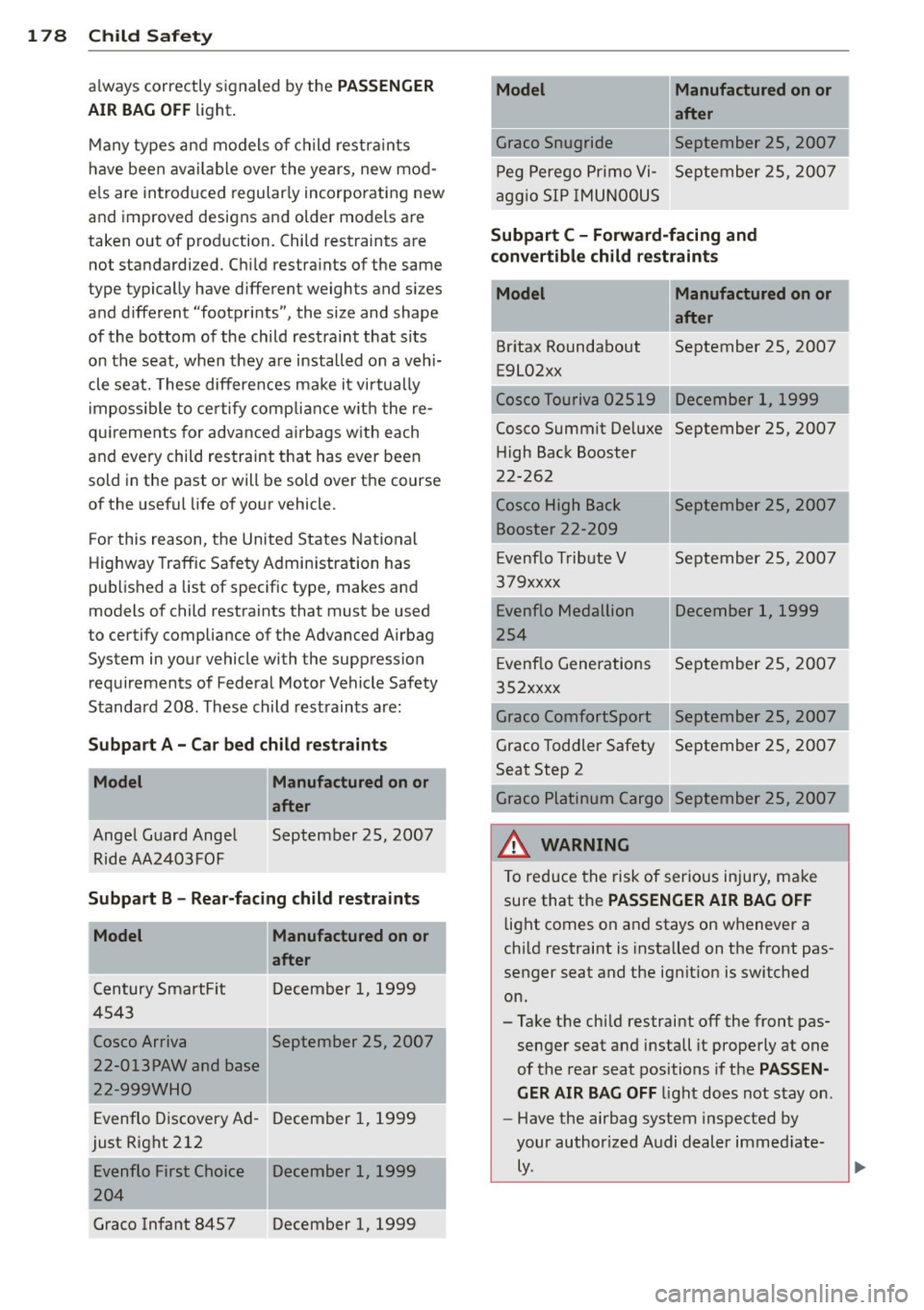
178 Child Saf ety
always correctly signaled by the PASSENGER
AIR BAG OFF
li g ht .
M any types and models of ch ild restra ints
have been ava ilable over the years, new mod
e ls are introduced regularly incorporating new
and improved designs and older models are
taken out of prod uction. Child restraints a re
not standardi zed. Ch ild restra ints of the same
type typically have different weights and s izes
and d ifferent "footprints", the size and shape
of the bottom of the child rest raint that sits
on the seat, when they are installed on a veh i
cle sea t. These differe nces ma ke it vi rtually
i mposs ible to ce rtify comp lia nce w it h the re
q ui rements for advanced a irbags w ith each
and every child restraint that has ever been
sold in the past o r will be sold over the course
of the useful life of yo ur vehicle.
F or this reason, t he United States Nat ional
Highway Traffic Sa fety Administration has
published a list of specific type, makes a nd
models of child restraints that must be used
to certify complia nce of the Advanced Airbag
System in yo ur vehicle with the suppress ion
requirements of Federal Motor Vehicle Safety
Standa rd 208 . These child rest raints are :
Subpart A -Car bed child rest raint s
Model
Ange l Guard Ange l
Ride AA2403FOF
Manufactured on or
after
September 25, 2007
Subpart B -Rear-facing child restraints
Model Manufactured on or
after
Century SmartFit December 1 , 1999
45 43
Cosco Arriva September 25, 2007
22-0 13PAW and base
l 22-999W HO
Evenflo D iscovery Ad-December 1, 1999
just Right 212
Evenflo First Choice December 1, 1999
1 20 4
Graco Infant 8457 December 1, 1999
-Model
Graco Snug ride
Manufactured on or
after
September 25, 2007
P eg Perego Primo Vi- September 25, 200 7
a ggio SIP IMU NOO US
Subpart C -Forward -facing and
convertible child restraints
Model Manufactured on or
after
Br itax Roundabout September 25, 2007
E9L02xx
December 1, 1999
Cosco Summit Deluxe September 25, 2007 H igh Back Booster
22-262
Cosco High Back September 25, 2007 Booster 22-209
E venf lo Tribute V September 25, 200 7
379xxxx
Evenflo Medallion December
1, 1999
254
E venflo Generations Se ptember 25, 20 07
352xxxx
Graco ComfortSport September 25, 2007
Graco Toddler Safety September 25, 2007
Seat Step 2
Graco Platinum Cargo Septembe r 25, 2007
.&_ WARNING ~
To reduce the risk of serious inju ry, ma ke
sure that the
PASSENGER AIR BAG OFF
light comes on and stays on whenever a
chi ld restraint is insta lled on the front pas
senger seat and the ignit ion is switched
on.
- Ta ke t he chi ld restraint off the front pas
senger seat and install it properly at one
of the rear seat positions if the
PASSEN
GER AIR BAG OFF
li ght does not s tay on .
- Have the airbag system inspected by
your author ized Audi dealer immed iate
ly .
Page 181 of 310
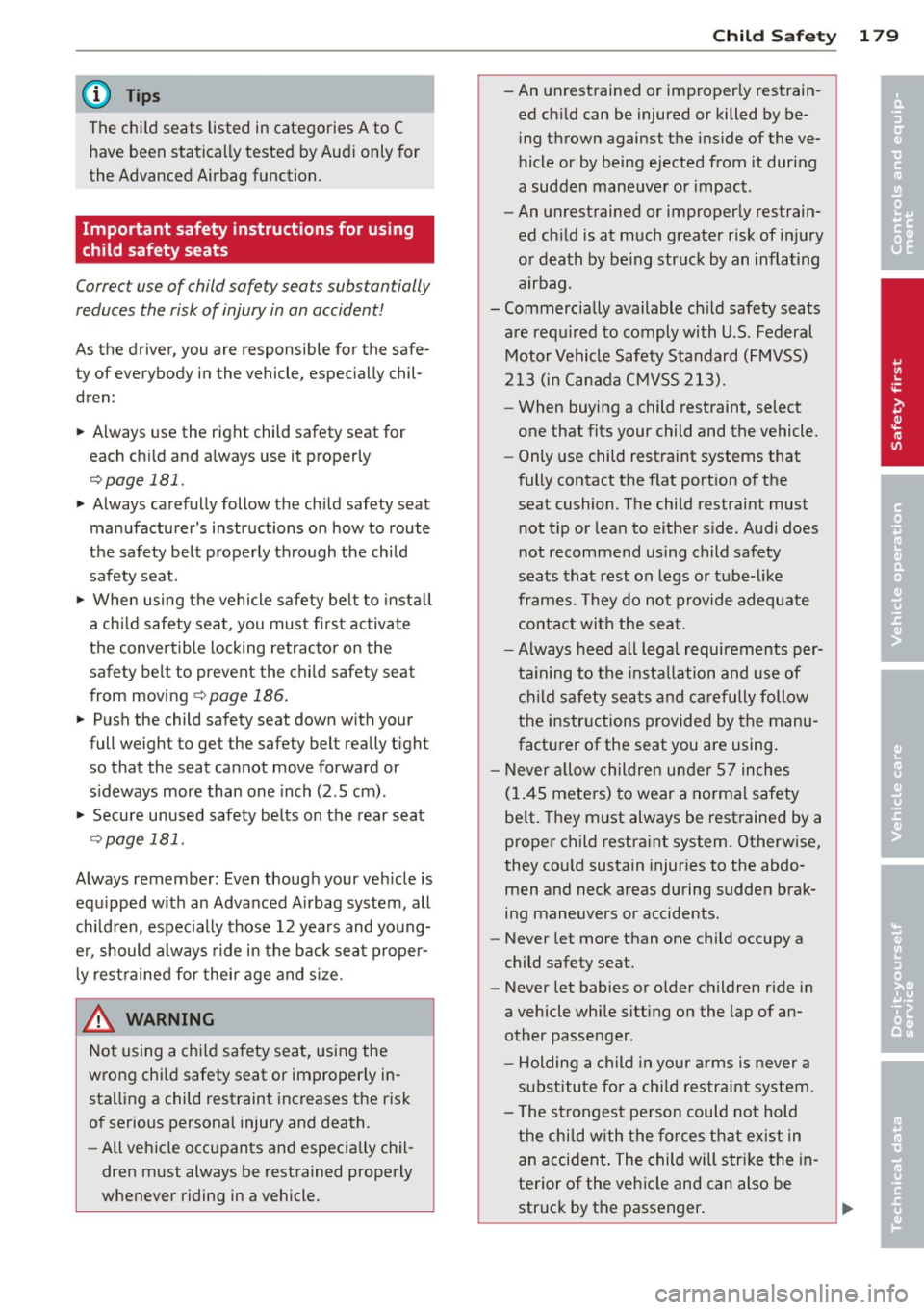
@ Tips
The child seats listed in categories A to C have been statically tested by Audi only for
the Advanced Airbag function.
Important safety instructions for using
child safety seats
Correct use of child safety sea ts substantially
reduces the risk of injury in an accident!
As the driver, you are responsible for the safe
ty of everybody in the vehicle, especially chil
dren:
~ Always use the right child safety seat for
each child and always use it properly
q page 181.
~ Always carefully follow the child safety seat
manufacturer's instructions on how to route
the safety belt properly through the child
safety seat.
~ When using the vehicle safety belt to install
a child safety seat, you must first activate
the convertible locking retractor on the
safety belt to prevent the child safety seat
from moving
r::!) page 186.
~ Push the child safety seat down with your
full weight to get the safety belt really tight
so that the seat cannot move forward or
sideways more than one inch (2.5 cm).
~ Secure unused safety belts on the rear seat
9page 181.
Always remember: Even though your vehicle is
equipped with an Advanced Airbag system, all
children , especially those 12 years and young
er, should always ride in the back seat proper
ly restrained for their age and size.
.&, WARNING ,~
Not using a child safety seat, using the
wrong child safety seat or improperly in
stalling a child restraint increases the risk
of serious personal injury and death .
- All vehicle occupants and especially chil
dren must always be restrained properly
whenever riding in a vehicle.
Child Safety 1 79
- An unrestrained or improperly restrain
ed child can be injured or killed by be
ing thrown against the inside of the ve
hicle or by being ejected from it during
a sudden maneuver or impact.
- An unrestrained or improperly restrain
ed child is at much greater risk of injury
or death by being struck by an inflating
airbag.
- Commercially available child safety seats are required to comply with U.S. Federal Motor Vehicle Safety Standard (FMVSS)
213 (in Canada CMVSS 213).
- When buying a child restraint, select
one that fits your child and the vehicle.
- Only use child restraint systems that
fully contact the flat portion of the
seat cushion . The child restraint must
not tip or lean to either side . Audi does
not recommend using child safety
seats that rest on legs or tube-like
frames. They do not provide adequate
contact with the seat.
-Always heed all legal requirements per
taining to the installation and use of
child safety seats and carefully follow
the instructions provided by the manu
facturer of the seat you are using.
- Never allow children under 57 inches
(1.45 meters) to wear a normal safety
belt. They must always be restrained by a
proper child restraint system. Otherwise,
they could sustain injuries to the abdo
men and neck areas during sudden brak
ing maneuvers or accidents.
- Never let more than one child occupy a
child safety seat.
- Never let babies or older children ride in a vehicle while sitting on the lap of an
other passenger .
- Holding a child in your arms is never a
substitute for a child restraint system.
- The strongest person could not hold
the child with the forces that exist in
an accident. The child will strike the in
terior of the vehicle and can also be
struck by the passenger. •
•
Page 183 of 310
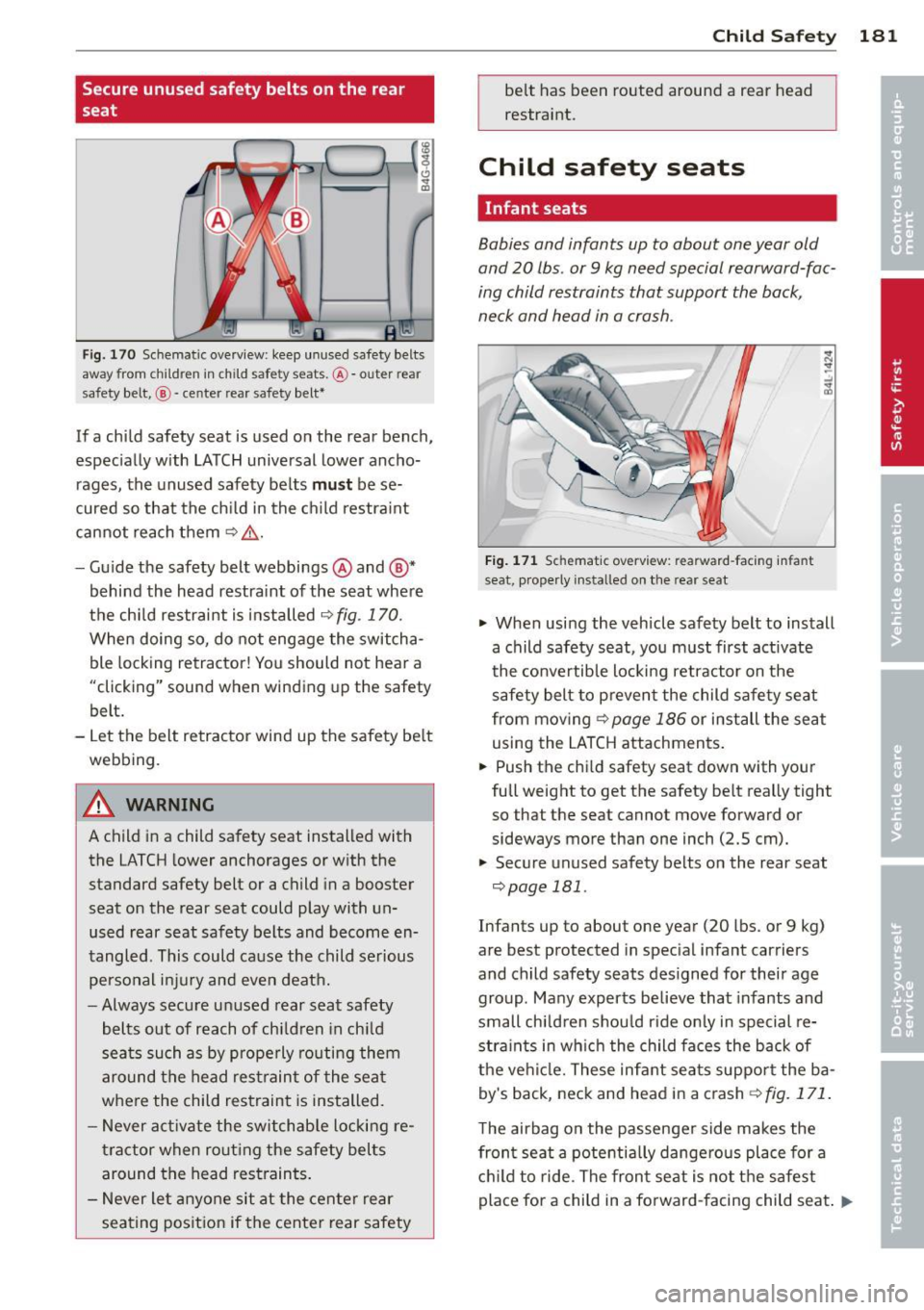
Secure unused safety belts on the rear
seat
F ig. 170 Schematic overview: keep unused safety belts
away from chi ldren in child safety seats. @-outer rear
safety belt,
@-center rear safety belt*
If a child safety seat is used on the rear bench,
espec ially with LATCH universal lower ancho
rages, the unused safety belts
mu st be se
cured so that the ch ild in the ch ild restra int
cannot reach them
Q ,&. .
- Gu ide the safety belt webbings @and @*
behind the head restraint of the seat whe re
the ch ild restrai nt is installed
Q fig . 170.
When doing so, do not engage the switcha
ble locking retractor! Yo u should not hear a
"clicking" sound when winding up the safety
belt.
- Let the belt retractor wind up the safety be lt
webbing.
A WARNING
A child in a child safety seat installed with
the LATCH lower anchorages or w ith the
standard safety belt or a child in a booster
seat on the rear seat could play with un
used rear seat safety belts and become en
tangled. This could ca use the child serious
personal i nju ry and even death.
- Always secure un used rear seat safety
belts out of r each of chi ld ren in ch ild
sea ts su ch as by p rope rly routing them
around the head res traint of the seat
whe re the child restraint is installed.
- Never act ivate the sw itchab le locking re
t ractor when rout ing the safety belts
around the head res traints .
- Never le t anyone sit at the center rear
sea ting pos it ion if the cente r rear safety Child S
afety 181
be lt has been ro uted around a rear head
restraint.
Child safety seats
Infant seats
Babies and infants up to about one year old
and 20 lbs. or
9 kg need special rearward-fac
ing child restraints that support the back,
neck and head in a crash .
Fig. 171 Schemat ic overv iew: rearward -facing infant
seat, properly installed on the rear seat
~ When using the vehicle safety belt to install
a child safety seat, you must first activate
the convertible locki ng retractor on the
safety belt to preven t the child safe ty seat
from mov ing
Qpage 186 or install the seat
using the LATCH attachments .
~ Push the child safety seat down with you r
full weight to get the safety be lt really tight
so that the seat cannot move forward or
sideways more than one inch (2.5 cm).
~ Secure unused safety belts on the rear seat
Qpage 181.
Infants up to about one year (20 lbs. or 9 kg)
are best protected in special infant car riers
and child safety seats designed for their age
group. Many experts be lieve that infants and
small chi ld ren shou ld r ide o nly in special re
str aints in wh ic h t he child faces the back of
the ve hicle. These infant sea ts suppo rt the ba
by's back, neck and head in a crash ¢
fig. 171.
The airbag on the passenger side makes the
fron t seat a pote ntia lly dange ro us place for a
c hi ld to ride. The fron t se at is not t he safest
place for a child in a fo rward -facing child seat . ..,_
Page 185 of 310
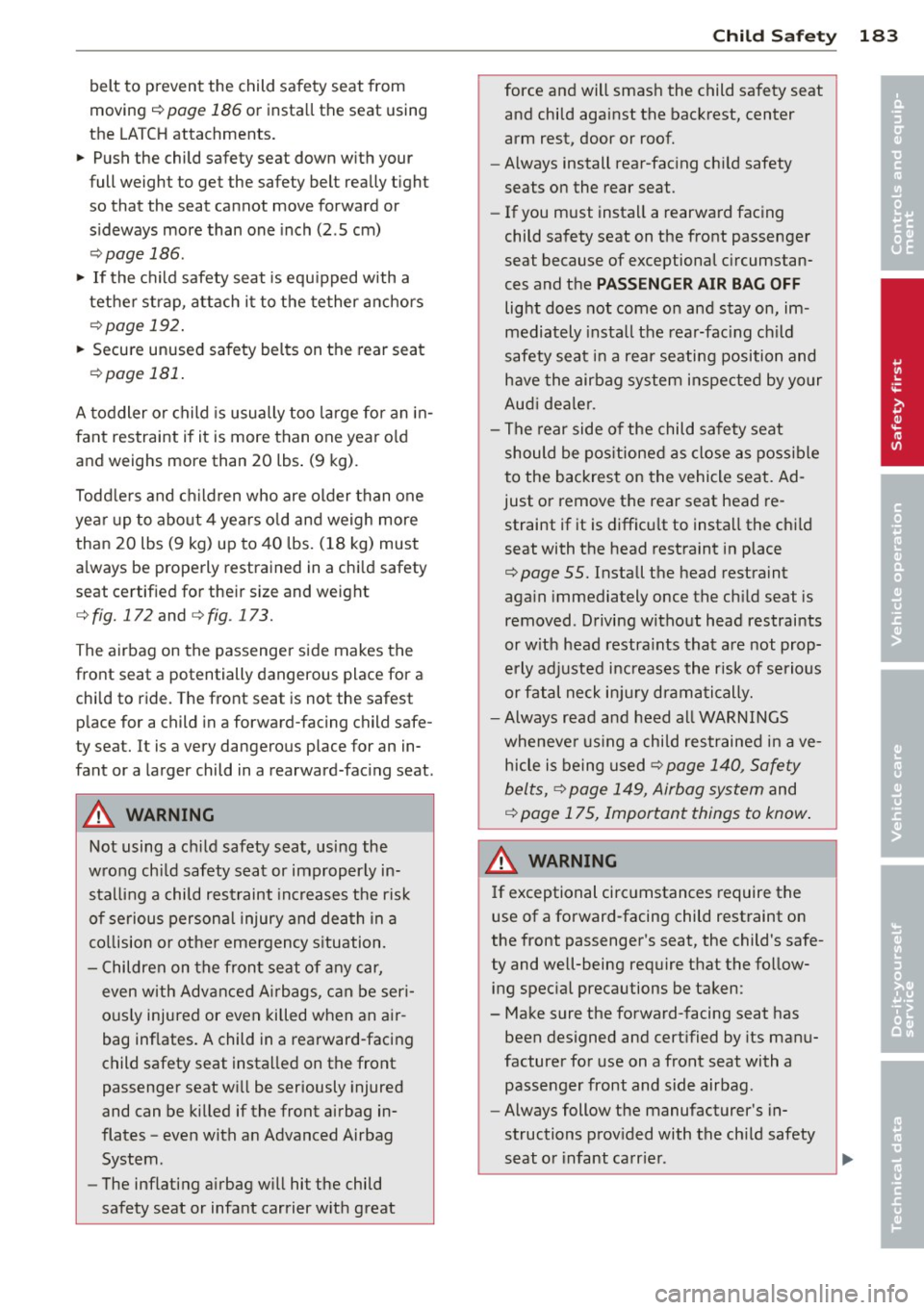
belt to prevent the child safety seat from
moving
r::!>page 186 or install the seat using
the LATCH attachments.
"' Push the child safety seat down with your
full weight to get the safety belt really tight
so that the seat cannot move forward or
sideways more than one inch (2.5 cm)
r::!> page 186 .
"' If the child safety seat is equipped with a
tether strap, attach it to the tether anchors
r::!> page 192.
.. Secure unused safety belts on the rear seat
r::!> page 181.
A toddler or child is usually too large for an in
fant restraint if it is more than one year old
and weighs more than 20 lbs . (9 kg).
Toddlers and children who are older than one
year up to about 4 years old and weigh more
than 20 lbs (9 kg) up to 40 lbs. (18 kg) must
always be properly restrained in a child safety
seat certified for their size and weight
r::!> fig. 172 and r:::>fig. 173.
The airbag on the passenger side makes the
front seat a potentially dangerous place for a
child to ride. The front seat is not the safest
place for a child in a forward-facing child safe
ty seat.
It is a very dangerous place for an in
fant or a larger child in a rearward-facing seat.
A WARNING
Not using a ch ild safety seat, using the
wrong child safety seat or improperly in stalling a child restraint increases the risk
of serious personal injury and death in a
collision or other emergency situation.
- Children on the front seat of any car,
even with Advanced Airbags, can be seri
ously injured or even killed when an air
bag inflates. A child in a rearward-facing
child safety seat installed on the front
passenger seat will be seriously injured
and can be killed if the front airbag in
flates -even with an Advanced Airbag
System.
- The inflating airbag will hit the child
safety seat or infant carrier with great
-
Child Safety 183
force and will smash the child safety seat
and child against the backrest, center
arm rest, door or roof.
- Always install rear-facing child safety
seats on the rear seat.
- If you must install a rearward facing
child safety seat on the front passenger
seat because of exceptional circumstan
ces and the
PASSENGER AIR BAG OFF
light does not come on and stay on, im
mediately install the rear-facing child
safety seat in a rear seating position and
have the airbag system inspected by your
Audi dealer.
- The rear side of the child safety seat
should be positioned as close as possible
to the backrest on the vehicle seat. Ad
just or remove the rear seat head re
straint if it is difficult to install the child
seat with the head restraint in place
r:::> page 55. Install the head restraint
again immediately once the child seat is
removed . Driving without head restraints
or with head restraints that are not prop
erly adjusted increases the risk of serious
or fatal neck injury dramatically.
-Always read and heed all WARNINGS
whenever using a child restrained in ave
hicle is being used
r::!> page 140, Safety
belts, r::!> page 149, Airbag system
and
r::!> page 175, Important things to know .
A WARNING ~
If exceptional circumstances require the
use of a forward -facing child restraint on
the front passenger's seat, the child's safe
ty and well-being require that the follow
ing special precautions be taken:
- Make sure the forward-facing seat has been designed and certified by its manu
facturer for use on a front seat with a
passenger front and side airbag.
- Always follow the manufacturer's in
structions provided with the child safety
-
seat or infant carrier . "" •
•
Page 186 of 310
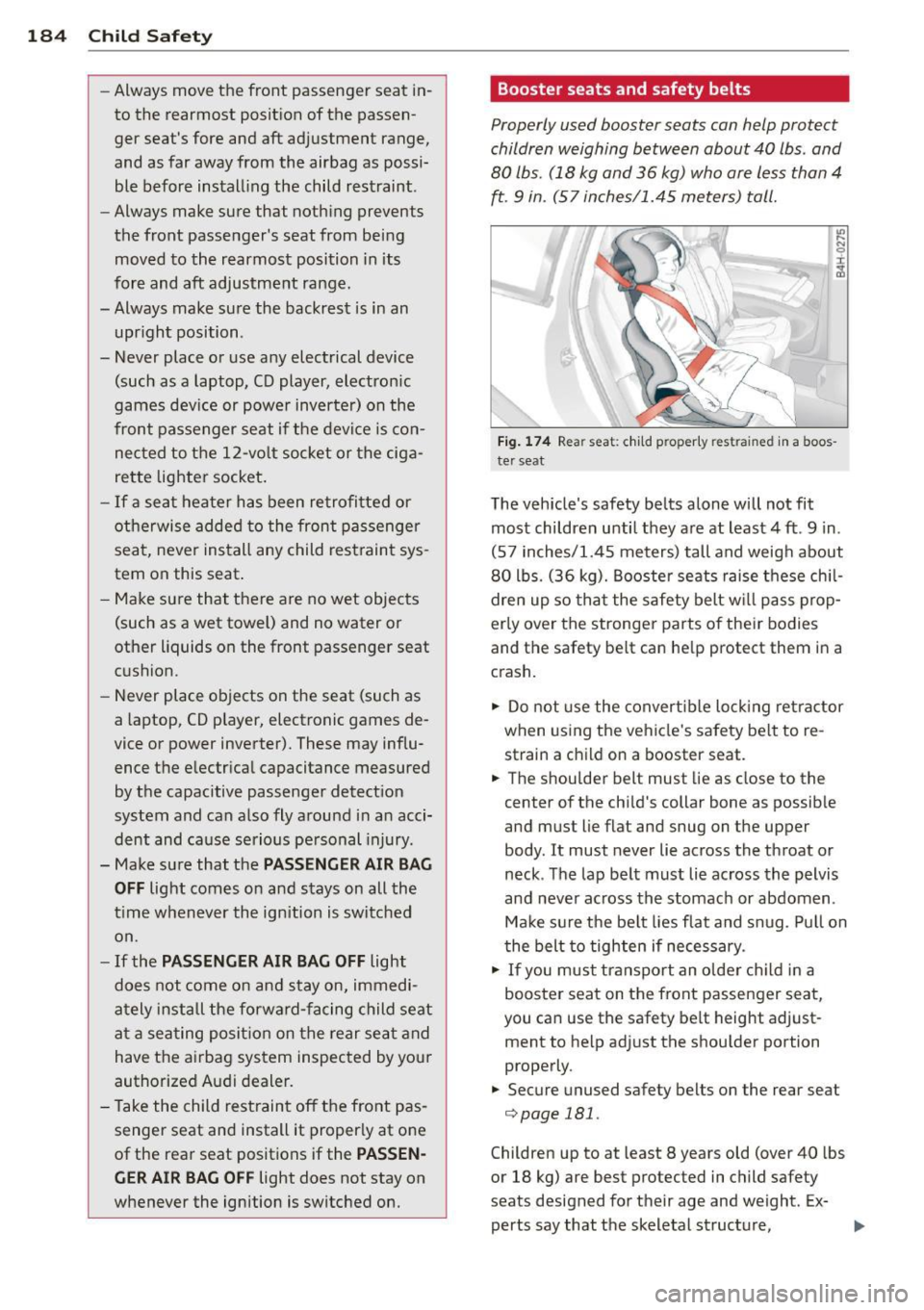
184 Child Safety
-Always move the front passenger seat in
to the rearmost position of the passen
ger seat's fore and aft adjustment range,
and as far away from the airbag as possi
ble before installing the child restraint .
- Always make sure that nothing prevents
the front passenger's seat from being
moved to the rearmost position in its
fore and aft adjustment range.
- Always make sure the backrest is in an
upright position .
- Never place or use any electrical device
(such as a laptop, CD player, electronic
games device or power inverter) on the
front passenger seat if the device is con
nected to the 12-volt socket or the ciga
rette lighter socket.
- If a seat heater has been retrofitted or
otherwise added to the front passenger
seat, never install any child restraint sys
tem on this seat.
- Make sure that there are no wet objects
(such as a wet towel) and no water or
other liquids on the front passenger seat
cushion.
- Never place objects on the seat (such as
a laptop, CD player, electronic games de
vice or power inverter). These may influ
ence the electrical capacitance measured by the capacitive passenger detection
system and can also fly around in an acci dent and cause serious personal injury.
- Make sure that the
PASSENGER AIR BAG
OFF
light comes on and stays on all the
time whenever the ignition is switched
on.
- If the
PASSENGER AIR BAG OFF light
does not come on and stay on, immedi
ately install the forward-facing child seat
at a seating position on the rear seat and
have the airbag system inspected by your
authorized Audi dealer.
- Take the child restraint off the front pas
senger seat and install it properly at one
of the rear seat positions if the
PASSEN
GER AIR BAG OFF
light does not stay on
whenever the ignition is switched on.
Booster seats and safety belts
Properly used booster seats can help protect
children weighing between about 40 lbs . and
80 lbs . (18 kg and 36 kg) who are less than 4
ft. 9 in. (57 inches/1.45 meters) tall.
Fig. 174 Rea r seat : child p rop erly res trained in a boos
te r se at
The vehicle's safety belts alone will not fit
most children until they are at least 4 ft . 9 in .
(57 inches/1.45 meters) tall and weigh about
80 lbs.
(36 kg). Booster seats raise these chil
dren up so that the safety belt will pass prop
erly over the stronger parts of their bodies
and the safety belt can help protect them in a
crash.
"" Do not use the convertible locking retractor
when using the vehicle's safety belt to re
strain a child on a booster seat.
"" The shoulder belt must lie as close to th e
center of the child's collar bone as possible
and mu st lie flat and snug on the upper
body.
It must never lie across the throat or
neck . The lap belt must lie across the pelvis
and never across the stomach or abdomen .
Make sure the belt lies flat and snug . Pull on
the belt to tighten if necessary .
"" If you must transport an older child in a
booster seat on the front passenger seat,
you can use the safety belt height adjust
ment to help adjust the shoulder portion
properly .
"" Secure unused safety belts on the rear seat
c:;,page 181.
Children up to at least 8 years old (ove r 40 lbs
or 18 kg) are best protected in child safety
seats designed for their age and weight . Ex-
perts say that the skeletal structure, ..,.